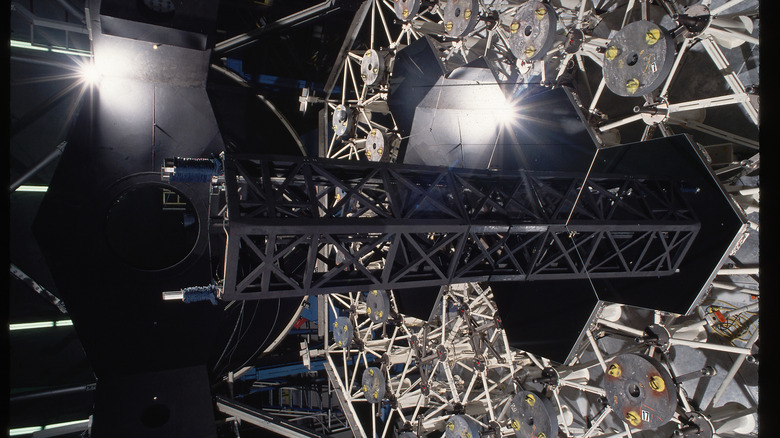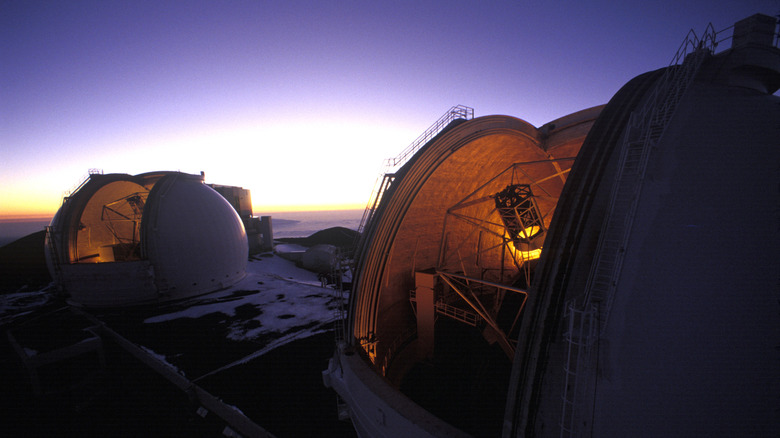Hawaii Has The Largest Reflector Telescope In The US But It's Not Run By Who You Think
Ever since the release of the first mind-bending images from the James Webb Space Telescope (JWST) on July 12, 2022, global interest in astronomy has been on the rise. And while humanity's most powerful space imaging instrument has rightfully seen its fair share of love recently (like being listed in our list of five times NASA broke records in 2024), less well-known are the hundreds of Earth-bound astronomical observatories that help scientists make sense of the mysteries of the universe.
Of these, the W.M. Keck Observatory, located on Hawaii's dormant Maunakea volcano, is one of the most impressive and collaborative in the global research community. The most scientifically productive observatory in the world, Keck, counterintuitively, isn't run by a local government agency but rather by the California Association for Research in Astronomy (CARA). CARA's Board of Directors features representatives from the University of California and the California Institute of Technology, both of which partner with the Keck Foundation and NASA on research projects.
Under this collective banner, scientists from around the globe push back the veil of unknowing in the cosmos by utilizing the observatory's two telescopes, which function in tandem to make up the largest reflecting telescope (those that converge parallel light rays to a focus) in the world.
The technical marvel of Keck's dual telescopes
The Keck Observatory's two telescopes are nothing short of engineering marvels, each featuring a 32-foot-wide (10-meter) primary mirror comprising 36 precisely aligned hexagonal segments. To get a better feel for just how technically smooth these mirror segments are, imagine scaling one up to the diameter of the Earth, a whopping 7,926 miles (12,760 kilometers) in length — the mirror's surface irregularities would rise no higher than three feet. These segments work in unison as part of a meticulously calibrated system. Using actuators and sensors, the position of each segment can be adjusted with astonishing precision to within four nanometers, equivalent to just 1/25,000 of the width of a human hair. This finely tuned alignment ensures the telescopes' mirrors function as a seamless, ultra-reflective surface.
In 1999, Keck Observatory became the first in the world to develop and install an adaptive optics (AO) system on a large-scale telescope, changing the way ground-based observatories capture images of the cosmos. This methodology uses a deformable mirror that reshapes itself 2,000 times per second, countering the turbulence caused by atmospheric particles and gases. While the observatory's telescopes are inherently powerful, the integration of AO allows Keck to achieve extraordinary clarity in the near-infrared spectrum — outperforming even the Hubble Space Telescope in detail.
Such spectacular images owe much of their existence to the specialized instruments within the observatory's walls that help capture and analyze data from the skies, including the Keck Cosmic Web Imager, a spectrograph and imager that researchers use to map the gaseous connections between galaxies. This instrument's contributions to locating non-repeating fast radio bursts in space led to Keck astronomers John O'Meara and J. Xavier Prochaska winning the 2020 American Association for the Advancement of Science Newcomb Cleveland Prize.
Keck Observatory's contributions to science
The W.M. Keck Observatory continues to push the boundaries of astronomical discovery, contributing critical research to the field. Among its recent achievements, Keck played a pivotal role in identifying Gaia BH1, the closest known black hole to Earth. Published in Monthly Notices of the Royal Astronomical Society in November 2022, the research paper proposing the black hole was built on data gathered from Keck's High-Resolution Echelle Spectrometer and Echellette Spectrograph and Imager, just two of the observatory's advanced suite of instruments.
In March 2024, researchers using Keck's telescope uncovered the faintest (and potentially most dark-matter governed) system orbiting the Milky Way: Ursa Major III / UNIONS 1 (UMa3/U1). This ancient star system provides valuable insights into the nature of dark matter and the processes ruling the formation of satellite galaxies. Tellingly, the reason for the grouping's lengthy name is its ambiguity; scientists are as of yet uncertain whether UMa3/U1 is a star cluster or a satellite galaxy, something further research into its levels of dark matter composition will hopefully reveal. Regardless, the discovery could represent an entirely new class of star systems.
Beyond discoveries, Keck Observatory is making strides in optimizing technical and logistical infrastructure to better observe transient celestial events (like supernovae and gamma-ray bursts) and more efficiently respond to these phenomena.
If you're interested in learning more about strange cosmic bodies and events, check out our explainers on blazars vs. quasars and the composition of a black hole.


